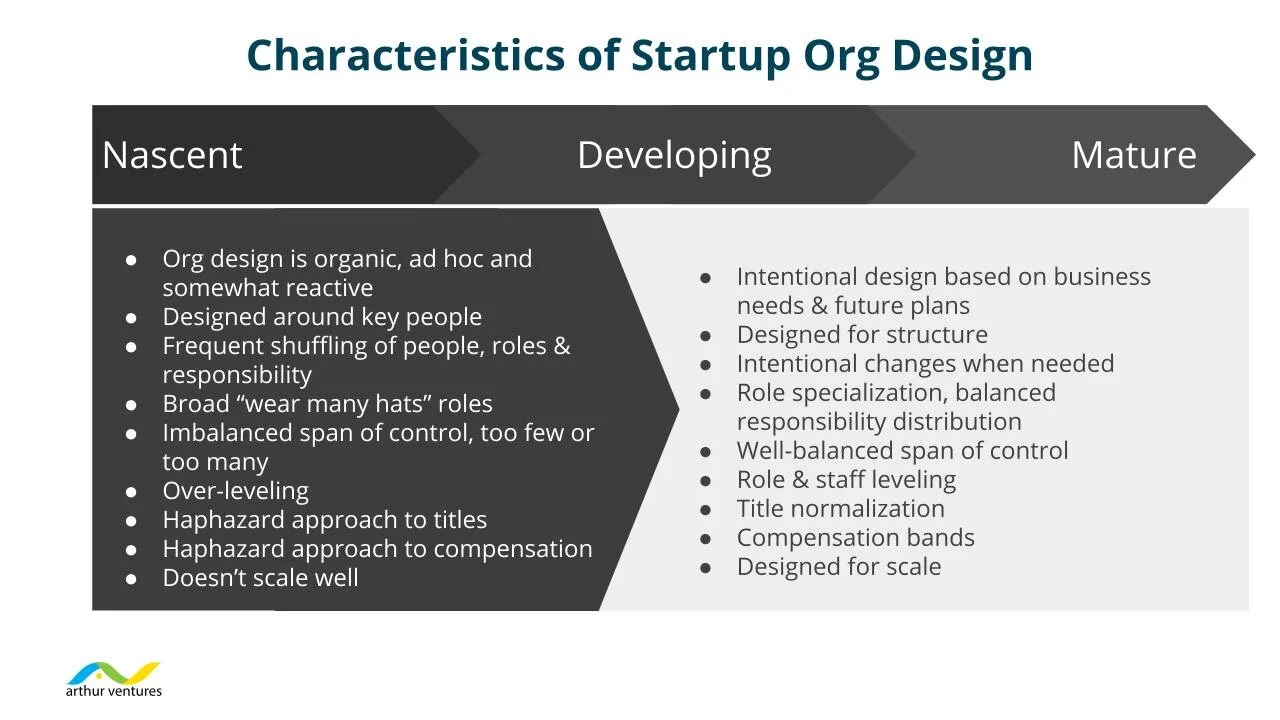Startup Org Design
In the early days of a high-growth startup, the organization isn't intentionally designed as much as it is cobbled together based on what is most pressing at the moment. Teams tend to organically sprout up. Roles are added too soon, too late, and when the stars align, at just the right time.
As soon as you have a team or function formed, the needs of the business have evolved and you need to switch people around in their roles and reporting lines. It's a constant evolution.
So, the phrase "Startup Org Design" is probably an oxymoron. And that's totally ok. Part of the fun of startup life is the chaos, constant change, and solving new problems every time you think you've got 'things figured out'.
But as a company scales it can be critically important to start to move towards a more intentional approach to organizational design. It doesn't have to be rigid or overly formal. But being more methodical helps the company run more efficiently.
At some point during a company’s growth trajectory, it comes time to sit down and think about the organizational structure and how it should be designed. From that point forward, org design usually becomes something that is evaluated at a regular cadence. In hyper-growth situations, it may be as frequently as every six months. In other companies, every 12-24 months is probably best.
What is org design?
"Org design gets the right people in the right places, empowers them to make decisions and then holds them accountable for their results." - An Elegant Puzzle
The above definition from An Elegant Puzzle (a fantastic book on engineering management) emphasizes that org design isn't just putting people into departments and determining reporting lines. The purpose of org design is really to empower people to do great work.
Formally, the six elements of org design include:
Chain of command. Who reports to who.
Span of control. How many reports a manager has.
Decision-making. Defines how decisions are made, who is involved. Centralized decision-making limits the number of people involved in decisions while decentralized is more input-based and autonomous.
Specialization. With low specialization, people wear many hats and roles tend to be more flexible. With more specialization, roles can be easier to recruit, train and scale.
Formalization. How much of the work is based on process, rules, and procedures.
Departmentalization. Grouping jobs based on function and common responsibilities and tasks. Common types of departmentalization are functional, geographic, and product.
Taking the elements of org design into account, you can see how it's more than departments and reporting lines—it's how the company, functions, teams, roles, and people work together as a unified organism.
How startup org design evolves
Startup org design evolves as the company evolves. Well, hopefully, it does.
As a startup grows, elements of the early days peel off, and there is a shift towards maturity. It doesn't happen overnight (nor does it need to). And it doesn't happen accidentally. In order to evolve, we have to be intentional and prioritize creating a healthy, productive organization.
Why it matters
Why does org design matter? This pretty much sums it up:
“Poor organizational design and structure results in a bewildering morass of contradictions: confusion within roles, a lack of coordination among functions, failure to share ideas, and slow decision-making bring managers unnecessary complexity, stress, and conflict.” -Gill Corkindale, HBR
Poor org design leads to inefficient work, lower employee morale, unnecessary friction, and lack of alignment.
When organizational design is haphazard and informal then you can be certain that:
Change is constant and often unnecessary or ineffective
Work is reactive versus proactive
Managers are over-taxed (which leads to disengaged teams and low productivity)
People are less productive and feel less clarity about the purpose of their work and how it fits into the overall company strategy and goals
There is a lack of alignment and effective communication across the organization
There are some wrong people in wrong roles
How to improve your org design
Learn. You don't need to get a master’s degree in org design (and yes, there is such a thing!). But it helps to orient yourself to the discipline of org design. I've listed some of my favorite resources at the conclusion of this article. They are a great place to start.
Seek advice & mentorship. You don't have to go at it alone or invent things as you go along. Ask for input from entrepreneurs, business advisors, your investors, and others who have experience scaling companies.
Think about structure and design, not specific people. You don't want to create an organization based on key staff, you want to create something that is scalable, improves alignment, and reduces friction. Likewise, avoid an org design structured around who works well together (and who doesn't). It's bigger than the current people you have in your company.
More resources
Want to learn more about org design? Here are a few of my favorite resources:
Team Topologies by Matthew Skelton and Manual Pais

